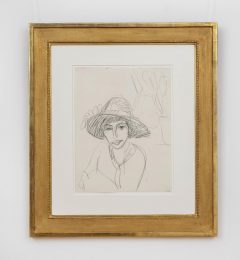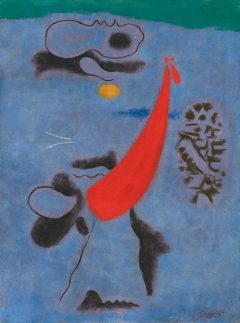Ernst Ludwig Kirchner
Gerda mit Hut
1913

Pencil on paper
51.8 × 39.7 cm / 20 3/8 × 15 5/8 in
Dated also verso with the Basel estate stamp vs and "B Be/Ba 24" also "Vgl. Ölbild Be/Ba 7" inscribed
With the pencil drawing »Two female nudes« on the verso, ca. 1914. A painting with a similar motif, »Portrait of Gerda«, from 1914 can be found in the Von der Heydt Museum in Wuppertal
This work is registered in the Ernst Ludwig Kirchner Archive Wichtrach/Bern
The artist's estate (Davos 1938, Kunstmuseum Basel 1946); Frankfurter Kunstkabinett (1968); LeRoy E. Hoffenberg, Baltimore (1988); Private Collection Florida, USA (by inheritance)
- Galerie Ludorff, "Neuerwerbungen Frühjahr 2024", Düsseldorf 2023
- Baltimore Museum of Art, "German Expressionist Graphics 1905-1985", Maryland 1988
- Staatliche Kunstsammlungen, "Ernst Ludwig Kirchner. Zeichnungen 1906-1925", 1. Juli - 28. Aug. 1967, Kassel
- Kunstverein für die Rheinlande und Westfalen, "Ernst Ludwig Kirchner", 9. Sept. - 20. Okt. 1960, Düsseldorf
- Galerie Ludorff, "Neuerwerbungen Frühjahr 2024", Düsseldorf 2024, S. 64
- Hanna Bekker vom Rath (Hg.), "Gemälde, Aquarelle, Zeichnungen, Druckgraphik und Plastik des XX. Jahrhundert", Frankfurter Kunstkabinett Kat. 11, Frankfurt 1968, Nr. 56
- Staatliche Kunstsammlungen, "Ernst Ludwig Kirchner. Zeichnungen 1906-1925", Ausst.-Kat., Kassel 1967, Nr. 51
- Kunsthalle Düsseldorf, "E. L. Kirchner", exh.-cat. 23, Dusseldorf 1960, Nr. 41
1912 was a very productive and successful year for Ernst Ludwig Kirchner. He had moved to Berlin the previous year, where he developed an independent style, detached from the other 'Brücke' artists, and created key works in his oeuvre. In February 1912, Kirchner took part in the exhibition 'Der Blaue Reiter' at the Hans Goltz Gallery in Munich and later at the Berlin gallery 'Der Sturm'. In May, the epochal book 'Der Blaue Reiter' by Wassily Kandinsky and Paul Klee is published, in which Kirchner also publishes a contribution. 'Die Brücke' shows its works at the Commeter Gallery in Hamburg, among other venues, and is invited to take part in the important international Sonderbund exhibition in Cologne. Kirchner is given the great honour of painting the exhibition's 'Kapelle' together with Erich Heckel. After the opening in May, Kirchner travelled with his new partner Erna Schilling and her sister Gerda to the Baltic Sea island of Fehmarn, where our wonderful drawing 'Segelboot an den Steinen' was created.
He describes his productive time on the Baltic Sea to the important collector and patron Gustav Schiefler as follows: As you probably know, I was back in Fehmarn this summer after a five-year break. I want to go again next year, the very strong impression of being there for the first time has deepened, and I have painted pictures of absolute maturity, as far as I can judge for myself. 1)
This pencil drawing shows a striking stretch of beach on Fehmarn with a high horizon and a small sailing boat sailing across the calm sea in the middle ground on the right. The viewer's eye is skilfully guided through the picture by the ice-age stone formations, which are distributed from front to back in a gentle arc along the surf. Kirchner seems to have been very enthusiastic about the landscape depicted, as he painted 'Ins Meer Schreitende' (Gordon no. 262, Staatsgalerie Stuttgart, see Fig. 1) in the same year, in which he again takes up the same striking rocks - but in this case viewed from the water.
The particular charm of our drawing lies in the rapid execution, which is very typical of Kirchner and limited to the essentials, and the nevertheless refined composition of this idyllic landscape, which inspired him to create new masterpieces and a significant further development of his style. In addition, the work, which comes from the high-calibre collection of 'Brücke' connoisseur Hermann Gerlinger, was on permanent loan to three public collections from 1995 to 2022.
While Kirchner's partner Dodo and the two girls Fränzi and Marcella were his favourite models during his time in Dresden, his encounter with two dancers in particular had a strong influence on the development of his Berlin style: in a tingeltangel bar, he first met Gerda and later her sister Erna, who became his partner after a brief relationship between the artist and Gerda. Kirchner himself wrote in retrospect: The design of the human being was strongly influenced by my third wife (Erna), a Berliner, who from then on shared my life, and her sister. The beautiful, architecturally constructed, strict bodies of these two girls replaced the soft Saxon bodies. 2) The artistic exploration of their nudes educated Kirchner's ‘sense of beauty to shape the physically beautiful woman of our time. 3) On the reverse of our sheet ‘Gerda mit Hut’ is a sketch of two female nudes, possibly showing the sisters.
On the front, a beautiful young woman looks directly and confidently out of the picture. The fact that it is Gerda can be recognised by her sensual, full lips. Kirchner is able to skilfully capture Gerda's modern appearance in just a few strokes. One recognises his mastery in the precise and rapid observation of the scene and its impressive realisation on paper. The artist himself writes about his drawings under a pseudonym: He [Kirchner] utilises the entire surface of the sheet in question. Not only the lines and the forms they create, but also the parts of the sheet that remain undrawn form the picture. 4)
'Gerda mit Hut' is one of Kirchner's favourite subjects from the Berlin period. He also varied it in 1914, for example, in the painting 'Bildnis Gerda' (Gordon no. 422, Von der Heydt-Museum, Wuppertal, see fig. 2). In 1988, the Baltimore Museum presented our drawing as part of the exhibition 'German Expressionist Graphics 1905-1985' (see fig. 3, p. 64).
1) E. L. Kirchner to G. Schiefler on 31 December 1912, from: 'Briefwechsel 1910-1935', Stuttgart/Zurich 1990, no. 33, p. 61
2) Ernst Ludwig Kirchner, 'Die Arbeit E. L. Kirchners', in: Eberhard W. Kornfeld, 'Ernst Ludwig Kirchner. Nachzeichnung eines Lebens', exhib. cat. Kunstmuseum Basel, Bern 1979, pp. 332-345, here p. 341, probably written in 1925/26
3) ibid.
4) L. De Marsalle, 'Zeichnungen von E. L. Kirchner', in: Lothar Grisebach: E. L. Kirchners Davoser Tagebuch, Eine Darstellung des Malers und eine Sammlung seiner Schriften, Cologne 1968, p. 185.






